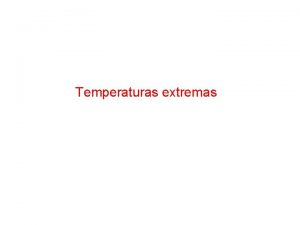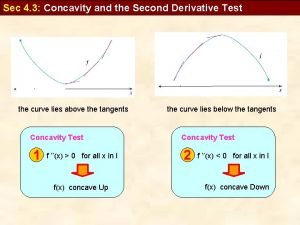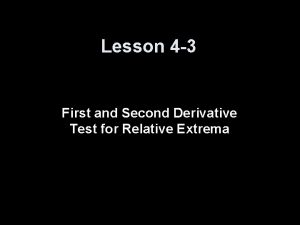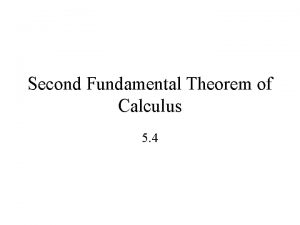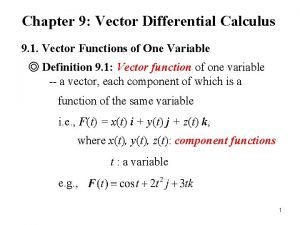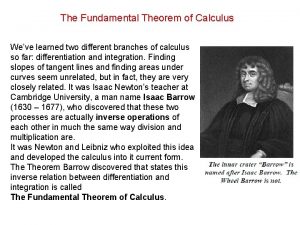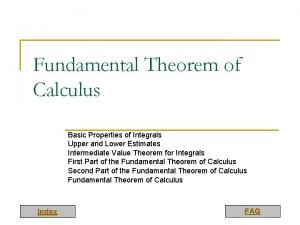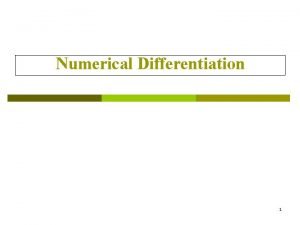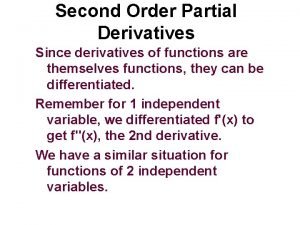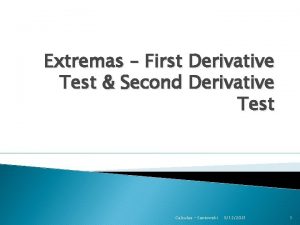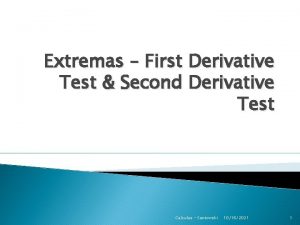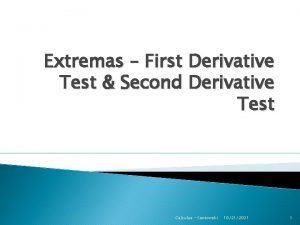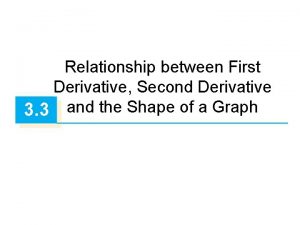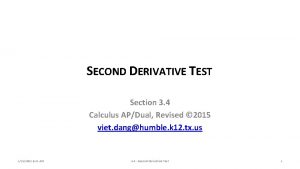Extremas First Derivative Test Second Derivative Test Calculus










- Slides: 10

Extremas – First Derivative Test & Second Derivative Test Calculus - Santowski 12/18/2021 1

Fast Five 1. Determine the first and second derivatives of the function f(x) = x 4 – 4 x 3 + 4 x 2 2. Determine the first and second derivatives of the function f(x) = x 4 – 4 x 3 3. Determine the first and second derivatives of the function f(x) = x 2 e-x 4. Determine the first and second derivatives of the function f(x) = 2 sin(x) + sin 2(x) Calculus - Santowski 12/18/2021 2

Lesson Objectives 1. Explain what the First Derivative Test is and why it “works” 2. Explain what the Second Derivative Test is and why it “works” 3. Work with the FDT & SDT to classify extrema Calculus - Santowski 12/18/2021 3

(A) First Derivative Test Let f be a differentiable function with f '(c) = 0 then 1. If f '(x) changes from positive to negative, then f has a relative maximum at c. 2. If f '(x) changes from negative to positive, then f has a relative minimum at c. 3. If f '(x) does not change sign at c, then f has neither an maximum or minimum at c. (Stationary point) Calculus - Santowski 12/18/2021 4

(A) First Derivative Test Use the FDT to classify all extrema of the function f(x) = x 4 – 4 x 3 + 4 x 2 Calculus - Santowski 12/18/2021 5

(B) Second Derivative Test Let f be a twice differentiable function near x = c such that f '(c) = 0. Then 1. If f ''(x) > 0 then f(c) is a relative minimum. 2. If f ''(x) < 0 then f(c) is a relative maximum. 3. If f ''(x) = 0 then use the first derivative test to classify the extrema. Calculus - Santowski 12/18/2021 6

(B) Second Derivative Test Your task: Write an explanation/clarification/rationalization of the FDT. Include diagrams in your explanation Calculus - Santowski 12/18/2021 7

(B) Second Derivative Test Use the function f(x) = x 4 – 4 x 3 to show algebraically HOW the SDT can be used to classify the extremas as either (i) maximums, (ii) minimums, or (iii) stationary points Calculus - Santowski 12/18/2021 8

(C) Examples ex 1. Find and classify all extrema using FDT of f(x) = 3 x 5 - 25 x 3 + 60 x. ex 2. Find and classify all extrema using SDT of f(x) = 3 x 4 - 16 x 3 + 18 x 2 + 2. Calculus - Santowski 12/18/2021 9

(C) Examples - FDT Ex 3. Find the intervals of increase and decrease and max/min values of f(x) = cos(x) – sin(x) on (- , ) Ex 4. Find the intervals of increase/decrease and max/min points of f(x) = x 2 e-x Ex 5. Find the local and absolute maximum & minimum points for f(x) = x(ln(x))2 Calculus - Santowski 12/18/2021 10
 Exposición a temperaturas extremas
Exposición a temperaturas extremas Concavity test
Concavity test What is the second derivative test
What is the second derivative test When does the second derivative test fail
When does the second derivative test fail The fundamental theorem of calculus
The fundamental theorem of calculus Directional derivative in vector calculus
Directional derivative in vector calculus Ftoc2
Ftoc2 Fundamental theorem
Fundamental theorem Forward derivative formula
Forward derivative formula Richardson extrapolation second derivative
Richardson extrapolation second derivative Partial derivative
Partial derivative
